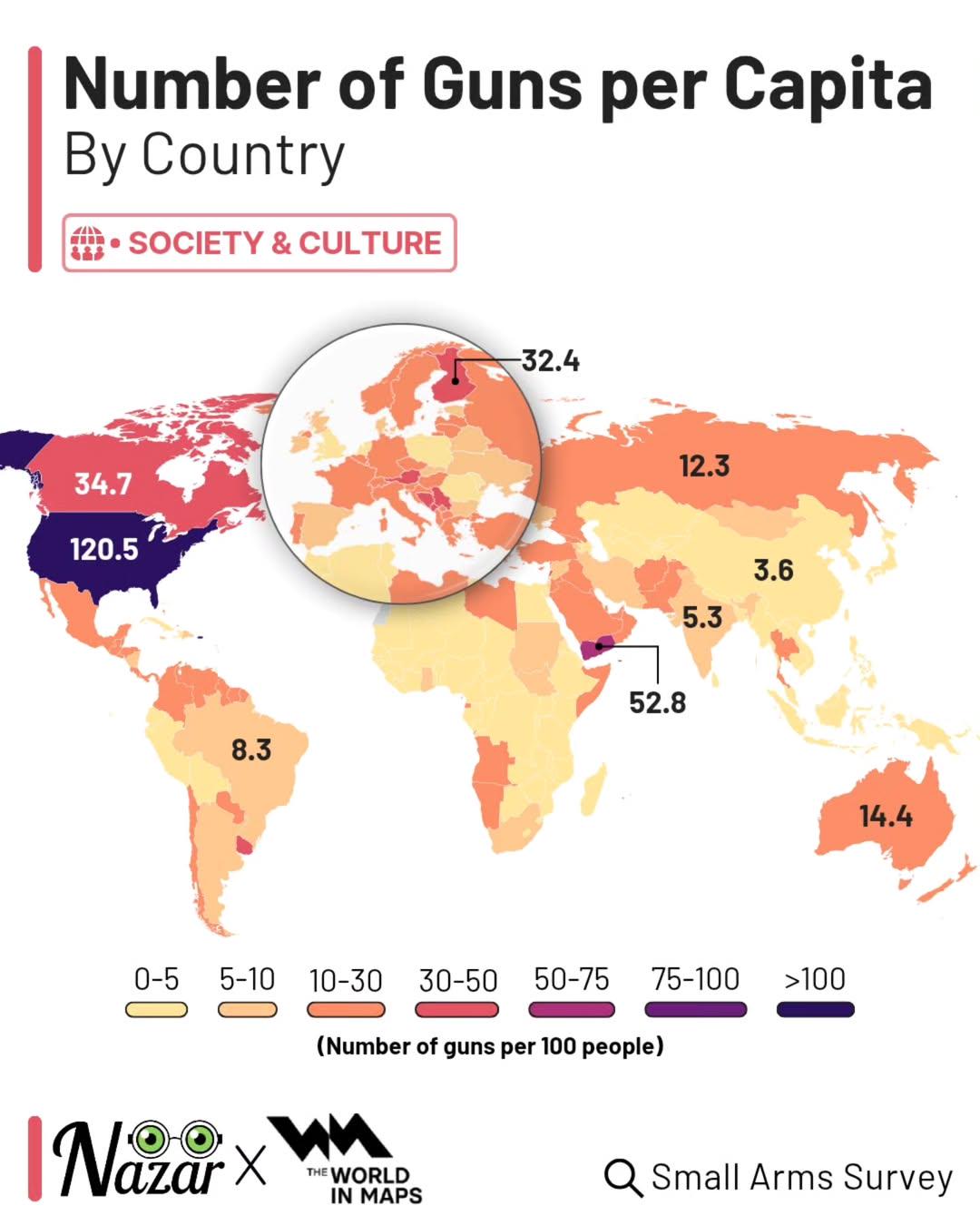Guns Per Capita by Country Map


David Chen
Data Visualization Specialist
David Chen is an expert in transforming complex geographic datasets into compelling visual narratives. He combines his background in computer science ...
Geographic Analysis
What This Map Shows
This map provides a clear visualization of the number of guns per capita by country, showcasing the stark differences in firearm ownership worldwide. It highlights how cultural, legal, and historical factors influence the prevalence of guns in different nations. By analyzing this data, we can gain insights into societal attitudes toward firearms and their regulation.
Deep Dive into Gun Ownership Trends
Gun ownership is a multifaceted issue that intertwines with various aspects of society, including culture, crime rates, and political structures. The number of guns per capita often reflects a country’s approach to personal safety, security, and individual rights. For instance, in the United States, where the right to bear arms is constitutionally protected, the number of firearms per person is staggering—over 120 guns for every 100 citizens, which is the highest in the world. This high figure can be attributed to a combination of cultural values that prioritize personal freedom and a strong gun rights lobby.
Interestingly, countries like Yemen and Switzerland also report high gun ownership rates, but for different reasons. Yemen's gun culture is deeply rooted in its history and tribal traditions, where firearms are often seen as a symbol of status and power. In contrast, Switzerland’s high gun ownership correlates with its militia system, where citizens are trained in firearm use and required to keep their service weapons at home, emphasizing a national commitment to defense.
In contrast, many countries with stringent gun control laws, such as Japan and the United Kingdom, report significantly lower rates of gun ownership—around 0.3 and 6.6 guns per 100 people, respectively. These nations have placed heavy regulations on gun ownership, focusing on public safety and crime prevention. For example, Japan requires extensive background checks, psychological evaluations, and a comprehensive training course before one can own a firearm, reflecting a societal choice to minimize gun violence.
The global average gun ownership rate is approximately 12 guns per 100 people, but this figure masks significant regional disparities. Exploring these differences can offer important insights into how societies manage the balance between individual rights and public safety.
Regional Analysis
When we break down gun ownership rates by region, distinct patterns emerge. North America, led by the U.S., dominates the chart with the highest per capita gun ownership. In contrast, Europe presents a mixed picture. Countries like Serbia and Montenegro have high rates, often linked to historical conflict and a legacy of militarization, while nations such as Germany and France maintain more moderate levels due to stricter regulations.
In Asia, the picture is varied as well. While countries like India have relatively low per capita gun ownership, reflecting their socio-economic conditions and strict laws, nations like Pakistan have a higher rate, influenced by regional conflicts and socio-political instability.
Interestingly, in Africa, the rates of gun ownership vary widely. Countries like South Africa have a significant number of firearms due to high crime rates, which drive citizens to seek personal protection. However, others, such as Mozambique and Angola, show lower rates, often due to ongoing conflicts and economic challenges that limit access to firearms.
Significance and Impact
Understanding the global distribution of firearms is crucial for several reasons. First, it helps illuminate the relationship between gun ownership and societal outcomes, such as crime rates and incidents of gun violence. For instance, countries with higher gun ownership often experience higher rates of gun-related deaths, although this is not a straightforward correlation due to various contributing factors.
Furthermore, the debate around gun control and ownership is increasingly relevant in discussions about public health and safety. As gun violence continues to rise in certain regions, policymakers face the challenge of balancing the rights of individuals with the need to ensure community safety. Current trends suggest that more nations may consider stricter gun control measures, reflecting a growing recognition of the need to address gun violence proactively.
Ultimately, this map serves as a visual representation of a complex issue that is deeply tied to cultural identity, legal frameworks, and individual rights. As we move forward, understanding the implications of gun ownership will be vital for fostering informed discussions about safety, rights, and responsibility on a global scale.
Visualization Details
- Published
- October 25, 2025
- Views
- 10
Comments
Loading comments...